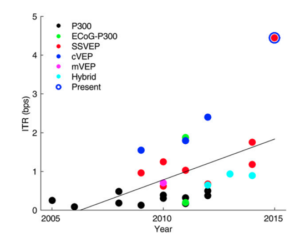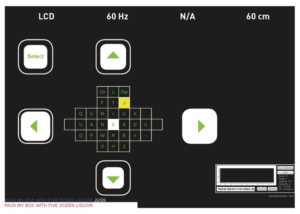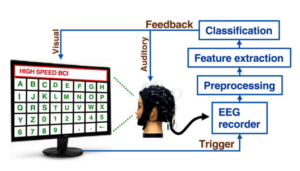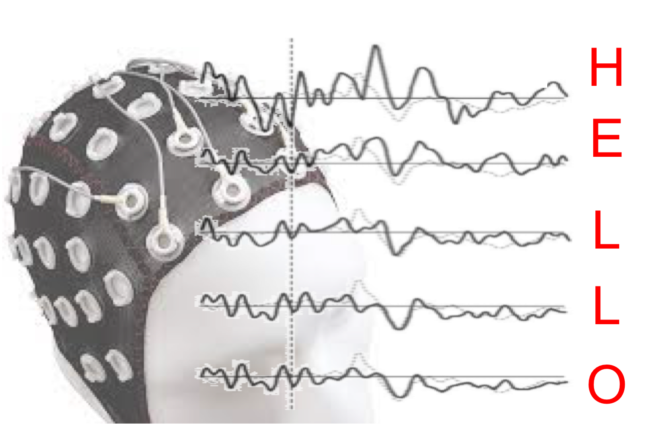SSVEP-based spellers, a common BCI application, have improved in information transfer rates over the years.
In the previous post we discussed the fundamentals of SSVEP-based BCI and the parameters that can affect their performance. In this post we will look at the design of SSVEP-based spellers, as they are one of the most common applications of BCI, considering that they are extremely useful for patients with severe motor disabilities, enabling them to communicate with others.
The performance of BCI is typically measured in terms of information transfer rate (ITR). ITR, measured as bits per trial, is computed by taking into account the accuracy of the BCI (correct command / total number of commands) , the number of possible selections (i.e. targets) and the average time for a selection. So the higher the ITR, the better. This website provides a nice overview on how to calculate ITR (https://bci-lab.hochschule-rhein-waal.de/en/itr.html). Basically it uses concepts from information theory to estimate the amount of information that is conveyed by the system.
When it comes to BCI spellers that are commonly implemented with EEG, the low SNR of EEG has limited the ITR to approximately 1 bits/second [1]. Especially the P300-based speller has very low ITR of around 0.5 bits/second [2]. Spellers based on SSVEP have shown to achieve relatively higher ITR of around 1.7 bits/second [3].

Figure 1 : ITR of the current BCI spellers. Hybrid means spellers implemented with multiple evoked potentials (example SSVEP and P300). The graph from [1] shows that the ITRs have been increasing over the years and the maximal ITR achieved is shown as Present in the graph.
The Bremen speller is one of the earliest high-speed spellers based on SSVEP. In this design, a 32-character keyboard is used along with five boxes (four arrows and a select button) as shown in the figure below.
 Figure 2 : The GUI layout of Bremen speller. The letters in the keyboard are arranged according to their probability of occurrence in the English language [4].
Figure 2 : The GUI layout of Bremen speller. The letters in the keyboard are arranged according to their probability of occurrence in the English language [4].
The five boxes surrounding the keyboard, flicker at different frequencies corresponding to the command – left, right, up, down and select. By focusing on one of five flickering boxes, the subject can move the cursor to the desired letter. At the beginning of each trial, the location of the cursor is reset over the character E. Also, the characters in the keyboard are arranged according to the frequency of their usage in the English language. Imagine that the subject has to spell the word EAT. This would require the following commands. (Note that after selection of each character, the location of the cursor is reset over the character E).
• select – since the cursor is already set over the character E at the beginning, this will select the character E.
• left followed by select – This will enable the used to choose the character A.
• up followed by select – This will enable the used to choose the character T.
Thus, to spell the word EAT a minimum of 5 commands are needed (select, left, select, up, select). In the Bremen BCI speller, an audio feedback is given after every recognized command. The bottom of the screen displays the current status of the spelling. For example, in the figure above the text – PACK MY BOX WITH FIVE DOZEN LIQUOR is shown. Also, it has to be noted that the navigation cannot move over the layout boundaries, i.e., you cannot move from L to H by choosing the command up. Improvements to the Bremen speller include addition of a built-in dictionary to predict the words as well as giving feedback to the user by increasing the size of the box, when the SSVEP signal increased, notifying the user that the selection was about to be made [5]. Studies have reported an average ITR of 0.43 bits/second, with an accuracy of 93.27%, which indicates a competitive performance, considering that patients with neural malfunctions participated in the study [5]. Several other high-speed spellers have been also been proposed (see [5] for detailed review) that include the row column design similar to the P300 speller as well as stimulation matrix resembling an alphanumerical keyboard (see Figure 2).
By using advanced signal processing methods, considerable improvement in the ITR can be achieved. For example in [1], it was shown that the SSVEP-based speller can achieve an ITR of 4.45 bits/second in online spelling tasks with healthy participants, using methods to precisely encode the frequency and phase of the stimulation signals in single-trial SSVEPs, with short stimulation duration. However, their method assumes visual latency across trials to be stable, in order to jointly code for frequency and phase of the stimulus. This assumption could be challenged, as shown in [6] that trial-to-trial variability of both amplitude and latency cannot be ignored.
 Figure 3 : High speed-BCI speller proposed in [1] that utilizes techniques to precisely encode the frequency and phase of the stimulation signals to achieve high ITR with single-trial SSVEPs.
Figure 3 : High speed-BCI speller proposed in [1] that utilizes techniques to precisely encode the frequency and phase of the stimulation signals to achieve high ITR with single-trial SSVEPs.
References
[1] Chen, Xiaogang, et al. “High-speed spelling with a noninvasive brain–computer interface.” Proceedings of the national academy of sciences 112.44 (2015): E6058-E6067.
[2] Farwell LA, Donchin E (1988) Talking off the top of your head: Toward a mental prosthesis utilizing event-related brain potentials. Electroencephalogr Clin Neurophysiol 70(6):510–523.
[3] Chen X, Chen Z, Gao S, Gao X (2014) A high-ITR SSVEP-based BCI speller. Brain-Comp Interfaces 1(3–4):181–191.
[4] Rezeika, Aya, et al. “Brain–computer interface spellers: A review.” Brain sciences 8.4 (2018): 57.
[5] Volosyak I., Cecotti H., Valbuena D., Graser A. Evaluation of the Bremen SSVEP based BCI in real world conditions; Proceedings of the 2009 IEEE International Conference on Rehabilitation Robotics; Kyoto, Japan. 23–26 June 2009; pp. 322–331.
[6] Truccolo, Wilson A., et al. “Trial-to-trial variability of cortical evoked responses: implications for the analysis of functional connectivity.” Clinical neurophysiology 113.2 (2002): 206-226.


Narayan, thanks for your article.
I do believe that cVEP (code based VEP) spellers have decidedly taken the lead in ITR in recent years. Below is a quite remarkable open source cVEP speller,
https://www.mindaffect.nl/
https://www.mindaffect.nl/brain-computer-interfaces/
https://www.mindaffect.nl/labs/
https://www.mindaffect.nl/press/
https://mindaffect-bci.readthedocs.io/en/latest/
https://scholar.google.com/citations?hl=en&user=6SDclmEAAAAJ&view_op=list_works&sortby=pubdate
https://iopscience.iop.org/article/10.1088/1741-2552/abecef/meta
“From full calibration to zero training for a code-modulated visual evoked potentials brain computer interface”
Well, your comment system appears to LOSE all the paragraph formatting I placed in the above comment. A shame, since it is now 10 times harder to read the links.
Thank you William, for your kind comments and useful links!